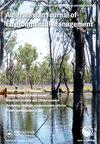新西兰坎特伯雷奶牛场硝酸盐浸出造成的牛奶灰水足迹
IF 1.5
4区 社会学
Q4 ENVIRONMENTAL STUDIES
Australasian Journal of Environmental Management
Pub Date : 2022-04-03
DOI:10.1080/14486563.2022.2068685
引用次数: 4
摘要
摘要在过去的三十年里,新西兰坎特伯雷地区经历了快速而显著的土地利用集约化,导致浸出到环境中的硝酸盐氮大幅增加。在本文中,我们确定了牛奶的硝酸盐灰水足迹,即稀释通过根区浸出的氮所需的水量,以满足每个牛奶生产单位不同的接收水硝酸盐标准。我们的分析显示,坎特伯雷的硝酸盐灰水足迹范围为每升牛奶433至11110升水,具体取决于所采用的水标准。这一足迹高于全球牛奶生产的许多估计,表明足迹在很大程度上取决于分析中的投入和适用于接收水的水质标准。坎特伯雷广泛的奶牛养殖导致该地区的地下水受到严重污染,其中大部分用于饮用水。这种强度的奶牛养殖是不可持续的,如果不减少,可能会对人类健康和市场对新西兰乳制品行业及其产品可持续性的看法构成重大风险。本文章由计算机程序翻译,如有差异,请以英文原文为准。
The grey water footprint of milk due to nitrate leaching from dairy farms in Canterbury, New Zealand
ABSTRACT The Canterbury Region of New Zealand has undergone rapid and significant land use intensification over the last three decades resulting in a substantial increase of nitrate-nitrogen leached to the environment. In this article, we determined the nitrate grey water footprint of milk, which is the amount of water needed to dilute nitrogen leached past the root zone to meet different receiving water nitrate standards per milk production unit. Our analysis revealed the nitrate grey water footprint for Canterbury ranged from 433 to 11,110 litres of water per litre of milk, depending on the water standards applied. This footprint is higher than many estimates for global milk production, and reveals that footprints are very dependent on inputs included in the analyses and on the water quality standards applied to the receiving water. The extensive dairy farming in Canterbury is leading to significant pollution of the region’s groundwater, much of which is used for drinking water. Dairy farming at this intensity is unsustainable and if not reduced could pose a significant risk to human health and the market perception of the sustainability of the New Zealand dairy industry and its products.
求助全文
通过发布文献求助,成功后即可免费获取论文全文。
去求助
来源期刊

Australasian Journal of Environmental Management
ENVIRONMENTAL STUDIES-
CiteScore
2.60
自引率
0.00%
发文量
16
 求助内容:
求助内容: 应助结果提醒方式:
应助结果提醒方式:


